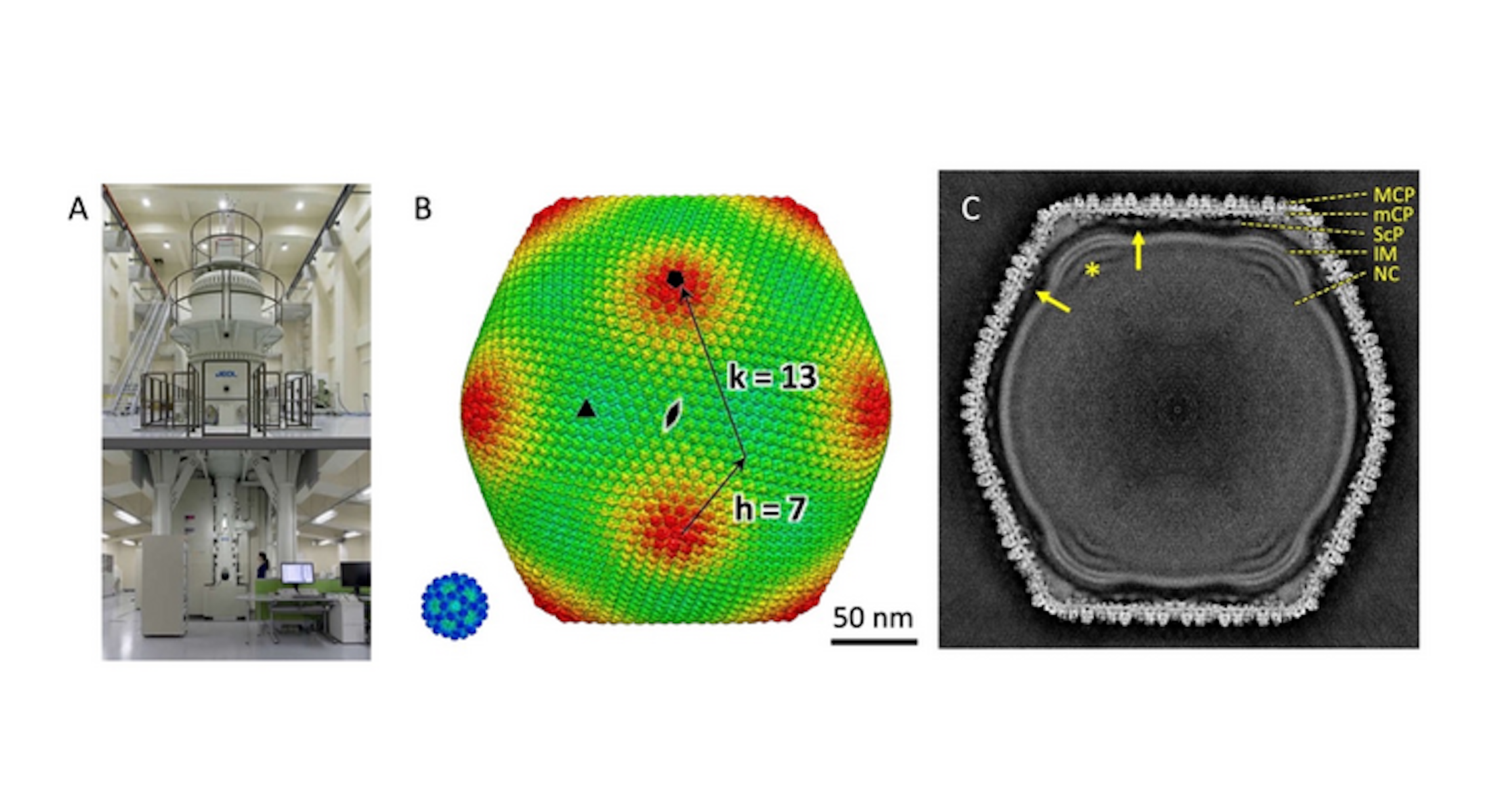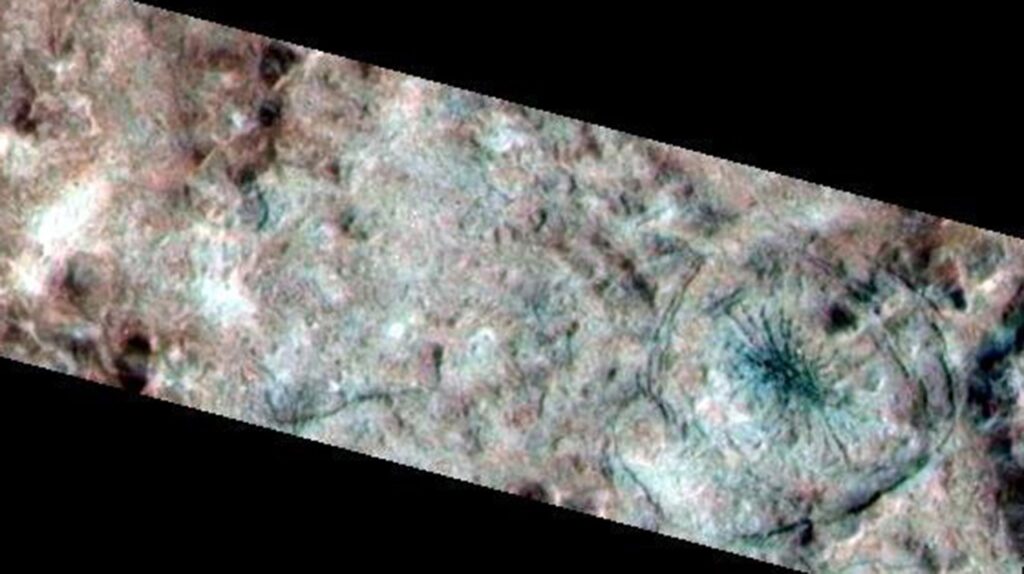Tricorder Tech: High-voltage Cryo-electron Microscopy Reveals Tiny Secrets Of Giant Viruses

Despite their name, giant viruses are difficult to visualize in detail. They are too big for conventional electron microscopy, yet too small for optical microscopy used to study larger specimens. Now, for the first time, an international collaboration has revealed the structure of tokyovirus, a giant virus named for the city in which it was discovered in 2016, with the help of cryo-high-voltage electron microscopy.
“Giant viruses” are exceptionally large physical size viruses, larger than small bacteria, with a much larger genome than other viruses,” said co-corresponding author Kazuyoshi Murata, project professor, Exploratory Research Center on Life and Living Systems (ExCELLS) and National Institute for Physiological Sciences, the National Institutes of Natural Sciences in Japan. “Few studies have revealed the capsid — the protein shell encapsulating the double-stranded viral DNA — structure of large icosahedral, or 20-sided, viruses in detail. They present special challenges for high-resolution cryo-electron microscopy from their size, which imposes hard limits on data acquisition.”
To overcome the challenge, the researchers used one of the few high-voltage electron microscopy (HVEM) facilities in the world that is equipped to image biological specimens. This type of electron microscope accelerates voltage to theoretically increase the power of the microscope, which allows for thicker samples to be imaged at higher resolutions. At the Research Center for Ultra-High Voltage Electron Microscopy at Osaka University, the team imaged flash-frozen tokyovirus particles, with the goal of reconstructing a single particle in full detail for the first time.
“Cryo-HVEM on biological samples has not been previously reported for single particle analysis,” Murata said. “For thick samples, such as tokyovirus with a maximum diameter for 250 nanometers, the influence of the depth of field causes an internal focus shift, imposing a hard limit on attainable resolution. Accelerating the voltage, or shortening the wavelength of the emitted electrons, can increase the depth of field and improve the optical conditions in thick samples.”
Prepared with these adjustments, the researchers imaged tokyovirus in detail to clarify the structure of the full virus particle. They achieved a 3D reconstruction at a resolution of 7.7 angstroms, a resolution just a bit lower than the technology could theoretically attain. Murata said that the result of the resolution was limited by the amount of data they could collect.
“Cryo-HVEM currently requires the manual collection of micrographs taken with the microscope,” Murata said. Micrographs are photographs taken with the microscope. “We identified 1,182 particles from 160 micrographs, which is an extremely small number compared to reports of other giant viruses imaged with less powerful microscopes.”
According to Murata, a lower magnification increases the number of particles included in each micrograph, but the magnification must be high enough to image the particles in detail. While the automated acquisition of micrographs — routinely used in standard cryo-electron microscopy — has facilitated a significant increase in the number of images captured at high magnification, but the manual mode allowed researchers to maintain a better particle count per micrograph while also maintaining a higher sampling frequency.
Even with limited samples and slightly lower resolution, Murata said, the researchers gathered enough information to better understand the giant virus particles structure with more clarity than ever before.

A) Particle structure of tokyovirus. From the outside, MCP: major capsid protein (light blue), mCP: minor capsid protein (blue), ScP: scaffold protein (yellow), IM: internal membrane (grey), covering the viral DNA inside. * is the protruding structure on the internal membrane. B) A novel network structure of mCP and ScP (yellow) in which 7 types of mCP structures are combined in a complex manner. mCPs are ScP are viewed from inside the shell. A triangular mCP network extends between the 5-fold vertices (bottom left and right). CREDIT Scientific Reports Creative Commons licence CC BY 4.0
“The cryo-HVEM map revealed a novel capsid protein network, which included a scaffold protein component network,” Murata said, noting that this scaffolding network’s connection between vertices in the icosahedral particle may determine the particle size. “Icosahedral giant viruses, including tokyovirus, have large, uniform sized functional cages created with limited components to protect the viral genome and infect the host cell. We are beginning to learn how this works, including the advanced functions of the structures and how we might be able to apply this understanding.”
The researchers plan to implement automated acquisition software capable of maintaining their desired parameters to image more giant virus structures and discover common architecture to better understand how the limited structures can be used for multifunctional organisms, Murata said.

A) The MCP structural model of another virus is fitted to the MCP density. The presence of unknown proteins other than MCP was recognized in the upper part (white area to which the structural model is not fitted). B) The unknown protein portion is shown in red. CREDIT Scientific Reports Creative Commons licence CC BY 4.0
Murata is also affiliated with the Department of Physiological Sciences in the School of Life Science at The Graduate University for Advanced Studies (SOKENDAI). Other contributors include co-corresponding author Chihong Song, co-first author Akane Chihara and co-first author Raymond N. Burton-Smith, who are affiliated with ExCELLS and the National Institute for Physiological Sciences; Naoka Kajimura and Kaoru Mitsuoka, with the Research Center for Ultra-High Voltage Electron Microscopy, Osaka University; and Kenta Okamoto, Program in Molecular Biophysics, Department of Cell and Molecular Biology, Uppsala University in Sweden. Song and Chihara are also affiliated with SOKENDAI.
Japan’s Ministry of Education, Culture, Sports, Science and Technology; Joint Research of ExCells; Cooperative Study Program of National Institute for Physiological Sciences; SOKENDAI; The Swedish Research Council; Swedish Foundation for International Cooperation in Research and Higher Education; and Royal Swedish Academy of Sciences supported this research.
A novel capsid protein network allows the characteristic internal membrane structure of Marseilleviridae giant viruses, Scientific Reports








